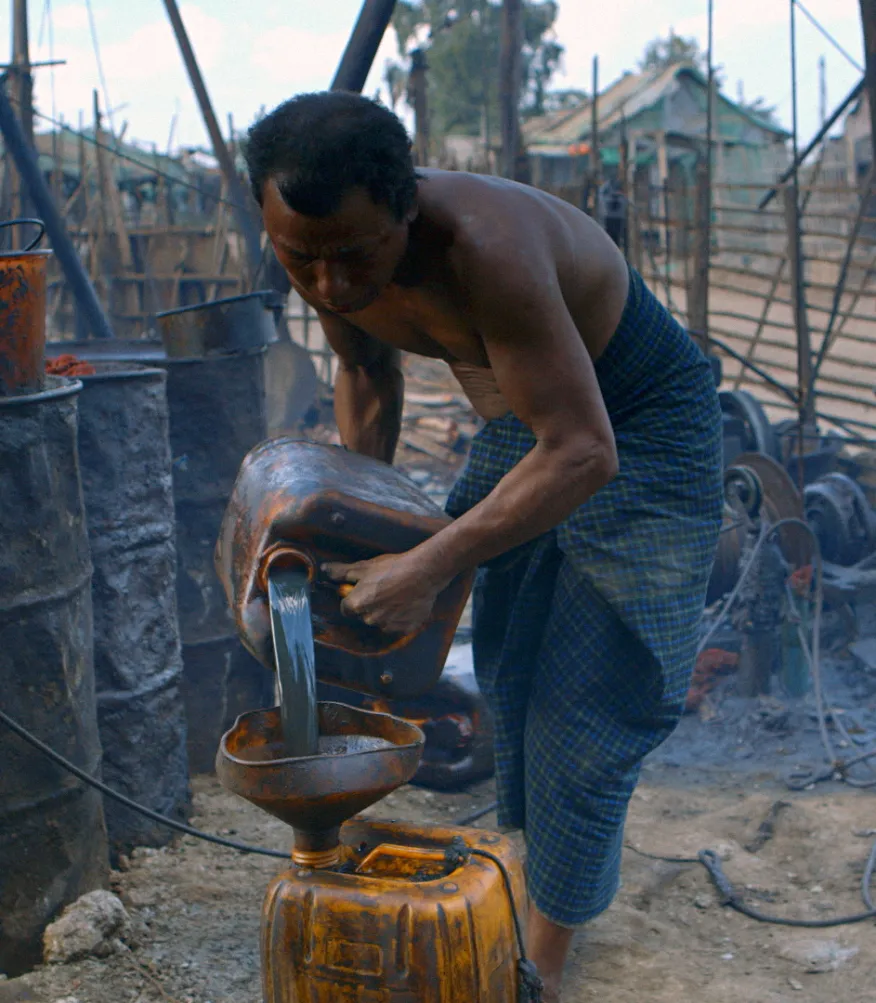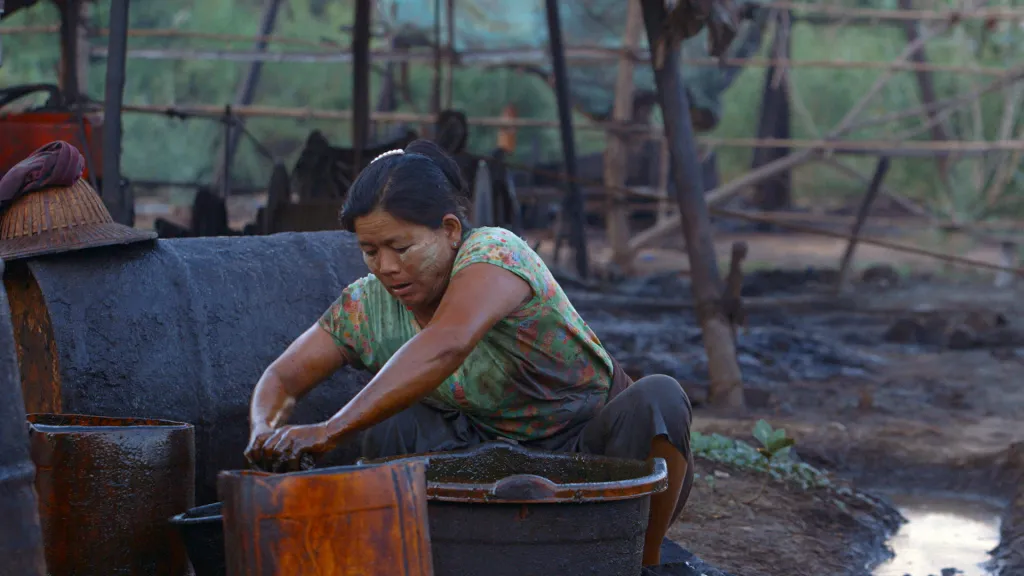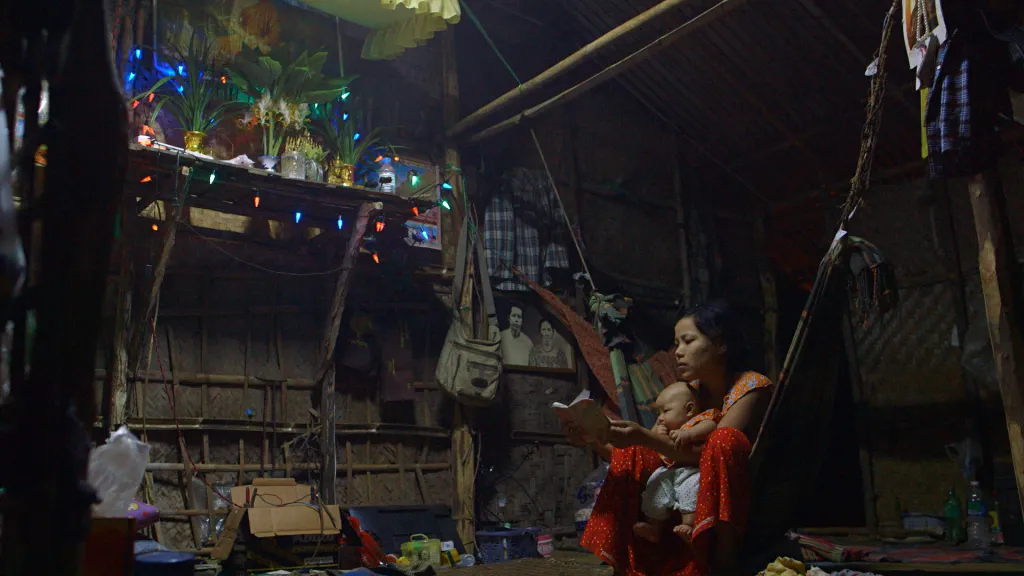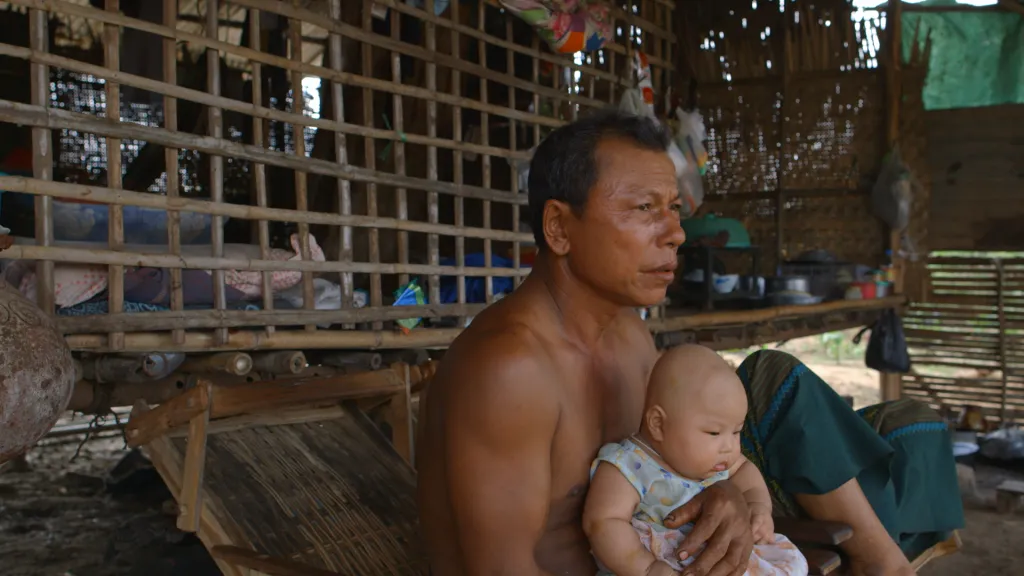Courtney Wittekind interviews filmmaker Saeed Taji Farouky about his film, “A Thousand Fires,” set in Magway.
A Burmese version of the post is available here.
“A Thousand Fires”, a new documentary by Palestinian-British director Saeed Taji Farouky, set in Magway, Myanmar, premiered in the Locarno Film Festival’s Semaine de la Critique earlier this year in August and will next, play in competition at the International Documentary Festival Amsterdam (IDFA). The film is centered around the daily lives of a Myanmar couple, Thein Shwe and Htwe Tin, whose precarious livelihoods in an unregulated oil field reveal Myanmar’s little-known status as the site of one of the world’s oldest petroleum industries. But while the film gestures to the contemporary afterlives of resource extraction and the histories of dispossession, expropriation, and exploitation which such processes involve, its plot is rooted in the more intimate wounds of a family in-flux. Thein Shwe and Htwe Tin manage to produce only a single barrel every few days, and the source of their fleeting stability—invisible and buried deep underground—is temporary and fleeting. Their wells may run dry at any moment, a reality that sits uncomfortably alongside their dreams of seeing their youngest son secure a life outside of oil industry. A kettle boils. Mud-slicked hands work sputtering machines. The ambient sound of a football match hums from a nearby television.

A story of intergenerational conflict and compromise, “A Thousand Fires” takes as its central thrust the complex unfolding of daily life in Magway: the rhythms of everyday labor, of lingering memories and a turbulent past; and of life persisting. It was awarded the 2021 Marco Zucchi Award, which recognizes films that are notable for their innovative aesthetic approach.
Courtney T. Wittekind and Saeed Taji Farouky sat down to discuss the film in September, soon after its release.
Courtney T. Wittekind (CTW): For those who might be unfamiliar with your previous work and method, can you first explain some of your background in film and how you came to the method and approach you’d employed in Magway?
Saeed Taji Farouky (STF): I’ve always been obsessed with cinema, and it’s always been a very powerful presence in my life, but I really only started with documentaries in 2004, after first making a few short fiction films for fun in college. At that time, I was becoming more politicized and had been watching a lot of films about the Arab world, and being Palestinian, the issues around how my community was represented was really important to me. Much of what I saw in Britain, where I was living, were misrepresentations—often a flattening of any complexity and of any character.
Two strands of thinking directed my passion toward documentary. One was the idea of storytelling through cinema, and the other was the idea that cinema could be used as a tool for social change, a tool for political communication. There’s a strong history of militant Palestinian filmmakers who are also part of the resistance, and so, from the beginning, I was attracted to political topics even though I also had a strong desire to make films about people’s lives.
My first major political film was “Tell Spring Not to Come This Year,” which I made in 2015 about the war in Afghanistan, told entirely through Afghan soldiers. That’s a great example of how I think about film. When I started that film, I knew I had to talk about Afghanistan in one way or another, but it was such an abstract issue, I didn’t know how to approach it. But I had the opportunity to follow Afghan soldiers for a full year, and in that process, I committed to making a very humanist story about them. It was a very personal, intimate approach, but it—of course—also addressed some major topics of global importance.
CTW: This more personal approach is the one you took in “A Thousand Fires,” too. How did you come about choosing to centre your film on this specific family in Magway? You hadn’t filmed in Myanmar before, but had you ever visited?
STF: No, I knew almost nothing about Myanmar…The way the whole film came together was very, very lucky, and that’s part of the reason I decided I needed to take the local Burmese conception of luck and fate seriously. So many elements of this film fell into place in a way that was quite magical.
I’ve always wanted to make a film about oil, but not about the mainstream oil industry. I wanted to focus on the production of oil on the periphery, and that was it—that was the starting point. But when we did research, there were so many places where there was once oil, or where experts say there may be oil in the future; we certainly weren’t going to wait years for oil off the coast of Angola, for example, to actually be discovered. We needed to get the right timing and location to find a place with small-scale oil production. I first saw a photo essay about hand-drilled oil fields in Myanmar, and that was it. That’s how it began, and from there, the process became one of narrowing down a big idea into a very simple human practice: this repetitive, physical work of digging and discovery.

CTW: Not knowing much about Myanmar before you started the film, how did you come to build the relationships that were foundational for the film. I mean, in terms of your Myanmar collaborators and the family with whom you filmed, but also about your relationship with Magway, as a place you needed to know intimately in order to film?
STF: I have a very unusual way of making a film, I guess. It takes a long time, and it can be quite difficult and uncertain and hard to fund, which is one of many reasons I have so much appreciation for my Burmese co-directors who worked with me so patiently throughout this project.
At the start of a project, I spend a lot of time watching passively. In the first two years of filming, I just sat and watched what happened around me, and I’m not sure much of that footage is even in the film. I spent as long as I possibly could, sitting in a corner, watching things happen, and listening very carefully because representing the experience of being in a space on-screen is very challenging. I listen to the sounds in a place and how they change throughout the day. I watch how things move and how the sky changes color, and I watch the quality of the light change. That last point is important because I got to a point where I was only filming about 30 minutes a day during that short period of time between the beginning and end of sunset. It was the lighting I wanted, given the lives and the kind of labor I was seeing. I knew it represented the mood of the film, even before it was finished.
When I film, there’s no real sense of story, no sense of narrative. It’s just a process of understanding the place, the landscape, and the story that comes later.
The other reason I like to begin by watching relates to the relationships with people. I want the film to reflect the pace and nature of people’s lives. One thing I find really frustrating with the approach to films is when a filmmaker has an approach, and it’s clear that they don’t engage or consider the culture around them. They just have their vision, and they impose it upon the place and people.
CTW: Yes, let’s shift to the question about building relationships with people. Were you with the family featured in the film from the start, or how did you meet them?
STF: We only met them on our second visit, the second of eight visits over four years. I had two Burmese assistant directors and myself, and we just went around visiting locations based on rumors about where a new oil field might be, or where there might be a new rush starting. Sometimes we would arrive at places, and there would be nothing. We’d be too late. Other times, it would just have been a rumor. And then, we found the area where we would eventually shoot the rest of the film. We started with someone else, who didn’t end up in the film because I didn’t feel the connection I was looking for with him.
But then I saw Thein Shwe, and I just felt something there. I saw him digging in the ground, looking for oil, and I just knew. I don’t know what it was, but the look on his face—he reminded me of my father. And after talking to him for a while, he said something very beautiful that really informs the rest of my film, which was: “I wonder what brought you halfway across the world to talk to me, maybe it’s because we were related in a previous life.” For me, that became the emotional heart of the film—this idea of a fairly brief existence on earth that’s full of both love and pain but part of a potentially endless process. This idea of a kind of enormous, endless cycle and line of influence has come to really structure the film, where everything feels like it has significance either because it is informed by the histories of thousands of years, or it’s going to inform thousands of years of other stories.
CTW: There’s so much there in the film, and it’s one of the reasons I was so stunned by it. There are so many nested cycles—this cosmic cycle that undergirds some of the conversations in the film, but then the generational cycle, the cycle of the discovery of oil and its end, which stands in for a kind of repeated cruelty of the boom-and-bust. Then, of course, there’s the day-to-day cycle of labor and rest, combined with the literal cyclical movement involved in oil extraction. So there’s that element, but then there’s also this dream of an emancipatory break—and in the case of the film’s plot, the hope for a pathway out for the son. Was this a theme that was there from the beginning or came about while you were filming?
STF: Early on, there was the idea of a physical cycle, just because the engine they use to dig is a flywheel, and it’s always turning. It’s percussion drilling, and so this drill is just going up and down for days and days. Then I started to see another cycle, which is that the family would drill for oil, they would reach it, collect it from the ground, and then pour the oil back into the machine to keep drilling. There’s this self-fulfilling prophecy in the search for more. It, of course, connects to the political. I’m not moralizing their lives at all because I understand that they are living in poverty and they personally have little choice, but on a global scale, it highlights the way the oil industry works as corporations—the drilling of oil, the burning of it, even though we know oil is hastening the destruction of the planet and ultimately, killing us.
I became really invested in this idea of small cycles existing within enormous cycles, and while speaking with the family about Buddhism and in doing my own research, I could see the multiple resonances. As time went on, the concept became more and more expansive for me. Some of these ideas I was familiar with from the Arab world. Of course, I’m Palestinian, and the Middle East has an incredibly rich history of folklore which have their own incredibly complex and exciting narrative structures. So much of the official history of storytelling is rooted in a European context and in Greek mythology, and that’s not the history I’ve inherited. I wanted something distinct, and I latched onto these very complicated, nested stories that you can find in medieval Arab literature, where there’s a sense of stories as self-fulfilling prophecies. I started integrating what I see as my own mythology, alongside what I learned in Myanmar about Burmese folklore and Burmese storytelling. There’s so much more to explore than the Canon of Greek drama, which has no bearing on our lives.

CTW: I know you had plans to continue working on the film, but COVID-19, but then with the military coup in February 2021, you decided to finish it with the material you had. How has the coup changed your sense of a film you made during what was a different moment in Myanmar? What does it feel like to be releasing it, knowing what’s happening in Myanmar now?
STF: What attracted me to make a film about oil, from the beginning, was that oil has always been used as a mechanism of oppression. That’s true in Myanmar as much as globally, whether that be during the time of the Japanese occupation who sought to control oil during WWII, or the military dictatorship, for whom oil was a major source of foreign currency and some of the only major international investment. In more recent times, oil was heralded as Myanmar’s savior, and we saw the very enthusiastic sale of exploration blocks.
In this sense, the film acknowledges something that is true in almost every country with oil, which is that oil becomes an instrument in every conflict, and the profits never end up with the people who labour for it. But, at the same time, there’s something hopeful too, because for someone like Thein Shwe, as a small-scale producer, he controls his own fate himself––even if only to a small degree. This is fascinating for me. The family I filmed is this tiny outfit that fills a barrel every three or four days—and that’s in the shadow of an industry that produces 3 million barrels in a week.
But beyond that, there are two incredibly subtle references to the military in the film, and when the coup happened, they became these real anchors because what was previously just off-hand mentions materialized. The whole process became much more emotional for me after the coup, and I believe now that the film should really be dedicated to the people of Myanmar, their incredible commitment, and continued bravery in resisting oppression.
For me, this is an extension of my activism—it’s activism through film—and that’s what motivated me when I was making films about the Arab world. What enables oppression, colonization, and imperialism to work is that these processes and mechanisms dehumanize people. If I can do anything with a film, it’s just to show a family that loves and suffers and has dreams. This film is like that. It’s slow and subtle but also pushing an anti-imperialist form of storytelling.

“A Thousand Fires” is a production of Les films du Balibari (France), in co-production with AKKA Films (Switzerland), BIND (Netherlands), and Odeh Films (Palestine). While the film is not yet available for streaming, the official trailer is online, and a wider festival and cinema release is scheduled for 2022. Visit the Facebook and Twitter pages for more information.
Saeed Taji Farouky is a Palestinian-British filmmaker, director, and cinematographer, known for A Thousand Fires (2021), Tell Spring Not to Come This Year (2015), and They Live in Forests, They Are Extremely Shy (2016).
Courtney T. Wittekind is an anthropologist, artist, and filmmaker currently completing her PhD in Social Anthropology at Harvard.
Like This Article
November 22, 2023
March 15, 2021
March 15, 2021